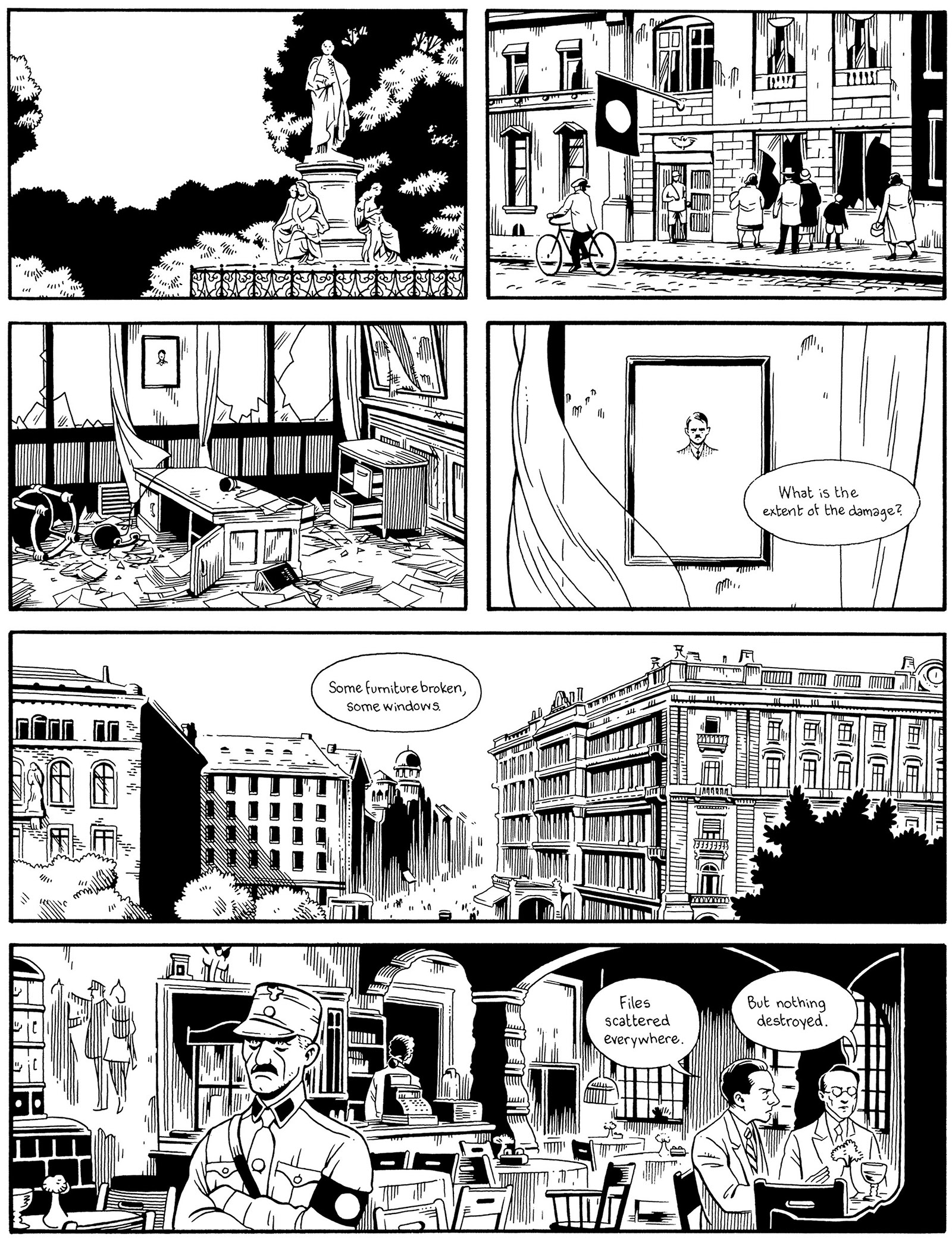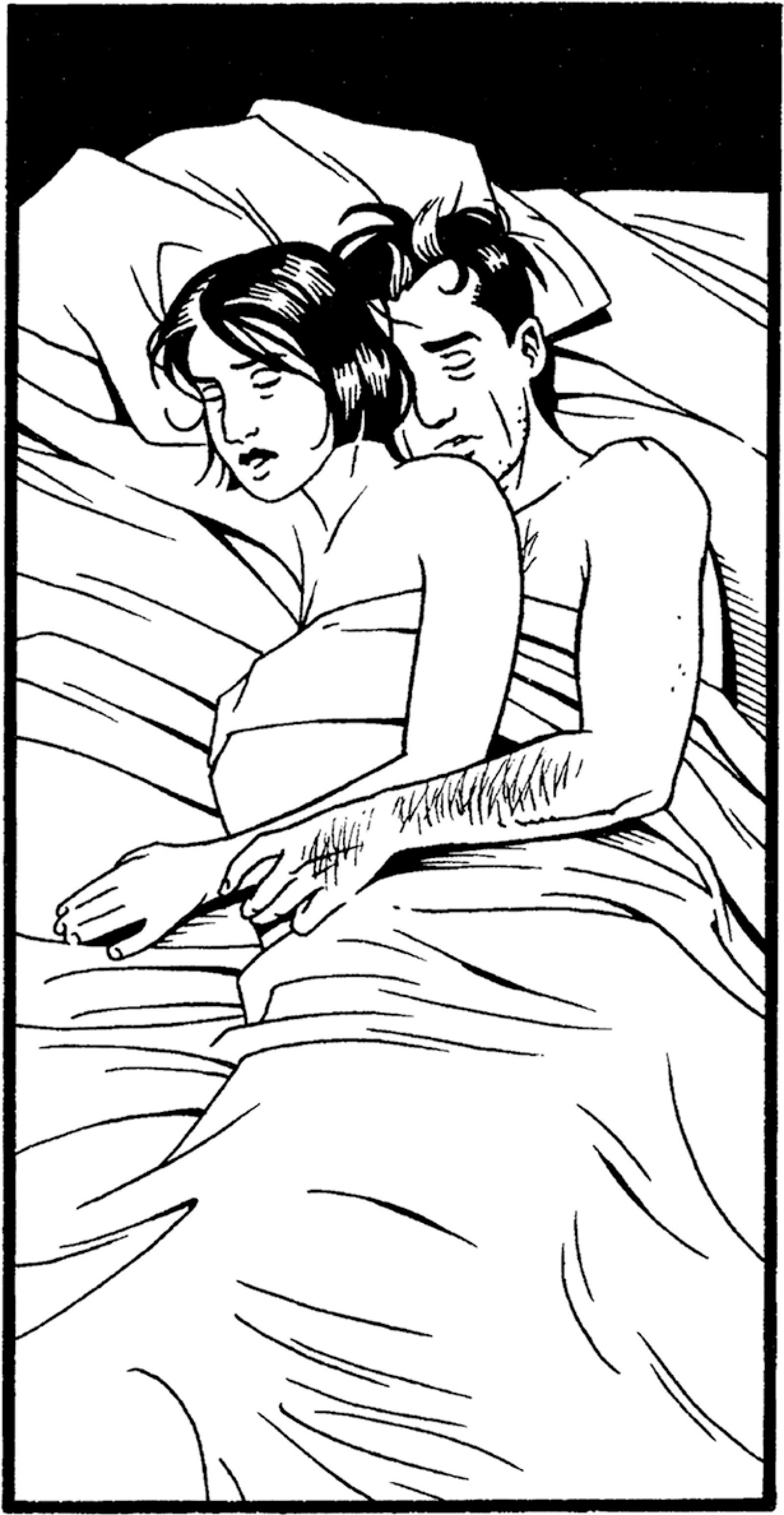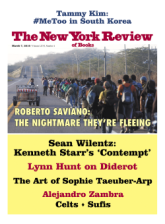In 1997 Jason Lutes, a comics editor and cartoonist in Seattle known for Jar of Fools, a graphic novel about an alcoholic magician and his senile mentor, set out to create an ambitious comic about Berlin in the late Weimar period, just before Hitler’s rise to power. The idea occurred to him when he happened to see an advertisement for a book of photographs called Bertolt Brecht’s Berlin. Before Lutes began his research—two years’ worth, as it turned out—most of what he knew of his subject, as he told me in an interview at a comics expo this past fall, came from the movie Cabaret. He didn’t speak or read German. At age twenty-eight, he figured the project might take him fourteen years to complete.
Twenty-one years later, at age fifty, Lutes was done. Although he published parts of Berlin serially along the way—first in small pamphlet-sized comics, then in three paperback volumes subtitled “City of Stones,” “City of Smoke,” and “City of Light”—the complete Berlin, nearly six hundred pages, can at last be read in one volume, a beautiful, fully baked brick. It includes a bibliography and a helpful key to the many persons, both real and fictional, populating the book.
The compositional principle of Berlin is montage. Lutes decided to structure his comic along the lines of Wim Wenders’s dreamlike movie Wings of Desire (1987) and Alfred Döblin’s epic novel, Berlin Alexanderplatz (1929), both of which duck in and out of various characters’ minds and lives. And so the pages of Berlin cut, sometimes abruptly, from street shots to close-ups, from train tracks to interior monologues, from newspapers to parlor rooms, and from one character to another. He devotes, for instance, an entire page to a (fictional) traffic guard thinking about the lunch his wife packed for him and whether the people he’s monitoring from his guard tower are more like cows or sheep. Then suddenly Lutes takes us inside the offices of the (real) newspaper Die Weltbühne, where the (real) poet Joachim Ringelnatz is making fun of the Nazi salute.
Montage, a staple of cartooning, is decentering by design. What Walter Benjamin wrote about Berlin Alexanderplatz in his essay “The Crisis of the Novel” can also be said for Lutes’s epic comic: “The texture of this montage is so dense that we have difficulty hearing the author’s voice.” In fact, Berlin has no authorial voice, no narration, no overarching perspective. Instead it has an atmosphere of aloofness. It is this impassivity that makes reading this book a deeply unsettling experience.
Bohemians, workers, artists, jazz musicians, thugs, and prostitutes fill its pages, but Berlin also has two main characters, both fictional. One is Marthe Müller, an unflappable young art student from Cologne, a newcomer to Berlin who carries her sketchbook around with her and draws “things I see, things that strike me.” The other is Kurt Severing, a world-weary journalist and pacifist who looks like a cross between Clark Kent and Walter Benjamin. He works for Die Weltbühne, writing both reported pieces and high-flown sociological essays of the Frankfurt School variety. (Indeed some of his words are exact quotes from the German philosopher Max Horkheimer.)
Both Kurt and Marthe, Lutes has said, represent aspects of himself. One is a writer, the other an artist. They are bourgeois rather than working class, flâneurs rather than firebrands. And their emotional temperature matches Lutes’s clear-line drawing style—cool and flat. (Think Tintin.)
As with Berlin Alexanderplatz and Wings of Desire, the unspoken hero of Berlin is the city itself, in all its fractured and disordered glory. Lutes’s wordless pictures of the city, especially at night, are some of the most dazzling passages in the book. In the course of Berlin we witness a few historic moments in the life of the metropolis: a festive zeppelin launch to celebrate President Paul von Hindenburg’s birthday in 1928; a massacre of workers on May Day, 1929, known as Blutmai; the death of Gustav Stresemann, Germany’s moderate foreign minister, in 1929. There are also historical guest appearances: Ernst Thälmann, the head of the Communist Party of Germany, the singer and dancer Josephine Baker, the future Nazi propaganda minister Joseph Goebbels, and, of course, Hitler.
When Lutes first began drawing and writing Berlin, his plan was to release Kurt and Marthe into the complicated biome of the real Berlin of 1928 to see what would happen. It was an experiment to find out what these flies on the wall of history would have perceived and experienced just before the Nazi horror show began. His choice of these two figures—passive, bourgeois, non-Jewish—means that while a lot swirls around them (some of their friends are arrested or beaten up), they themselves remain relatively unaffected.
Advertisement
Marthe clearly stands apart from her fellow art students. While her friends are fervent Expressionists in the mold of the woodcut artist Frans Masereel, or Dadaists, or devotees of the Neue Sachlichkeit (the politically charged graphic satire of Otto Dix and George Grosz), Marthe, with her steady head and hand, does soft, realistic sketches from life. Her drawings are competent but lack conviction. She does have a notable quirk: her drawings of men sometimes look like women, and those of women sometimes look like men. Despite this oddity she comes across as a game ingenue with few genuine passions. Although she has a fling with Kurt, she is just as happy in bed with Anna Lencke, a cross-dresser who sees herself as a man. She hangs out with Berlin’s intellectuals and bohemians but is not one of them. Her most direct brush with history is when Anna, who is perhaps the most convincing and sensitively rendered figure in the story, is swept up in a police roundup of homosexuals and transvestites. This traumatic event surprisingly leaves Marthe a little annoyed at Anna’s moping.
Kurt plays a more consequential part. His boss, Carl von Ossietzky—the (real-life) editor in chief of Die Weltbühne who won the Nobel Peace Prize in 1935—has assigned him to report on Germany’s illegal rearmament. When Ossietzky is charged with treason and jailed (which actually happened), Kurt becomes, as he himself calmly types, “outraged anew,” and his mind is filled with visions of Grosz caricatures. But he does not act. Unlike his friends, who are politically engaged, he remains neutral. He almost joins the Communist Party, but doesn’t. He gets depressed. He drinks and isolates himself. He burns his writings, finding them futile. His most violent move is to rip the gramophone needle from a jazz record that Marthe is playing.
Even in their darkest moments, Marthe and Kurt have a preternatural calm about them. This is one of the most disturbing—and in the end most powerful—aspects of the book. Benjamin’s observation about the characters in Berlin Alexanderplatz, and about Berliners in general, holds true for Lutes’s characters, too: “Whether [a Berliner] is swearing, mocking, or threatening, he takes his time, just as he takes his time over breakfast.” Watching these characters saunter into the arms of Nazism—while they worry about how bourgeois they really are or whether jazz is frivolous or not—is like seeing a killer creeping up quietly on his victim in a horror movie. You want to shout, Watch out! But what good would it do?
When Lutes began drawing Berlin, he has said, he didn’t want to know what would happen in his story, despite knowing where Germany itself was headed. Indeed, one of the book’s most haunting passages is its coda, a series of spreads showing Berlin after 1945. There’s a bombed-out Berlin, a barbed-wired Berlin, a graffitied, breached-wall Berlin, and, last, a photograph of contemporary Berlin.
The question is why Lutes chose such passive observers as Kurt and Marthe as his witnesses. Perhaps he was following the literary tradition of having an observer, an Ishmael of sorts, as the reader’s eye during important events. Or perhaps it was just to make the reader feel the horror of the passivity of most Germans at this historical moment.
Whatever the case, these two figures seem primarily to be not fully rounded characters but mere portals to other characters. Marthe is our entrée to an assortment of bohemians and intellectuals, whom we see at masked balls, nightclubs, jazz parties, and cocaine-infused orgies. And Kurt is a portal to the political world. He leads us to Irwin Immenthaler, a (fictional) radical who tries to pull Kurt into the Communist orbit, and, on the other end of the political and social spectrum, to an (also fictional) socialite, Countess Margarethe von Falkensee, Kurt’s ex-lover, who becomes a friend to Hitler.
If I were to pick one word to describe Berlin, it would be “fragmented.” And this fits well with Lute’s montage aesthetic. In a process that amounts to a kind of social mitosis, one character meets another, causing a third and fourth to emerge. This splitting and multiplying of persons and viewpoints gives each one not only a connection to all the rest in a six-degrees-of-separation way, but also a strangely provisional status. They connect to one another, but not with one another. They are isolates colliding, particles in a world heating up.
Take, for instance, Gudrun Braun, a beaten-down working mother of three who almost joins the Communist Party out of guilt and gratitude. Lutes draws her to look a decade older than she is supposed to be, and he kills her off early, in volume 1, on May Day, 1929, during the massacre of workers. Although Lutes does win some feeling for Gudrun by evoking her interior life (we see her death from her point of view), she nonetheless seems strangely bland. But through her, we are introduced to others. We get to know the man who pushed her toward the party, Otto Schmidt (a smiling man in a cap). We also meet Gudrun’s husband, a hard-bitten, unemployed worker with close-cropped hair who hates Communists and Jews and becomes a Nazi, along with his son, Heinz. The Brauns seem to have been devised to show how a family can fragment so that one part becomes Communist and the other Nazi.
Advertisement
However, there is one member of the Braun family who seems whole, not merely part of a puzzle—Silvia, Gudrun’s daughter. She is a tough girl with ratty blond hair and refreshing rage. Just after her mother is killed on Blutmai, Silvia tries to kill Schmidt, who roped Gudrun into joining the May Day rally. Out of hunger and desperation, she then teams up with a Jewish scavenger, Pavel, who saves her from prostitution and finds a place for her to live, with a Jewish family. (Lutes’s portrayal of this family as ingrown shtetl Jews may seem an off-key choice given how many Jews in Berlin were well assimilated, or at least thought they were.) Finally Silvia breaks away from this Jewish family and becomes a radical, sometimes disguising herself as a boy so she can sell the worker’s newspaper (the Arbeiter-Illustrierte-Zeitung).
Silvia is the only character with enough fury to try to stop the Nazis. She bites, she stomps, she yells. Toward the end of the book she tries to burn down the Nazi headquarters, and there she confronts her knife-wielding little brother, Heinz. She stops at nothing.
In the end, though, character doesn’t matter, for in a sense all of the figures in Lutes’s book—whether Jews, Aryans, Nazis, Communists, pacifists, warriors, workers, cross-dressers, artists, journalists—are just parts of the puzzle. No one is intrinsically good or bad. This is true of not only Berlin’s fictional characters but even of the historical ones. We see a nervous Goebbels, before he becomes a monster, and we see Hitler accepting a bouquet from a small blond child who turns out to be Silvia’s little sister. Bizarrely, Hitler’s big close-up is almost a humanizing gesture: he scratches his own cheek.
It’s hard to tell what Lutes intends by zooming in on such details. But to a reader, the effect is to put all the characters, real and invented, Nazi partisan and ordinary citizen, on an equal plane. One person can be best distinguished from another not so much by actions as by more superficial things—especially hairdos, caps, mustaches, and eyewear. Kurt is his glasses and weak eye. Workers are always in caps. Women are their hairdos: Silvia, with her dirty blond hair, has a boy’s choppy haircut, then braids. Anna has a mannish cut and round black glasses. Margarethe has short, wavy hair. Marthe has long loose wisps and sometimes a beret. (Because of some hairdo and hat confusion, I thought that at one point Marthe had become a prostitute; only the pattern on the prostitute’s beret changed my mind.)
Of course, comic books have always relied on types, tokens, and visual quirks to distinguish the dramatis personae, but here this reliance seems to go along with a dismal view: individual character doesn’t count; history is a matter of chance encounters; the course of humanity is beyond human control.
Although Berlin is, on a certain level, a novel of graphic emblems, there is one crucial emblem that is almost entirely absent: the swastika. In a few instances swastikas can be seen scrawled on the walls of buildings, but Lutes chose for the most part to leave it off the Nazi flags and armbands because, he said, it would have had an overwhelming effect on today’s readers that it simply didn’t have at the time. By removing this distraction, he was, he suggested, trying to recreate the psychological experience of being on the street in 1928, 1930, 1933. So wherever the swastika would have been—on flags and on armbands—he replaced it with an empty white circle.
That missing swastika is the most shocking detail in the book. It suggests, I think, that few people saw the Nazi emblem or Nazi Party for what they were, and that practically everyone was blind to the possible future. Even the most analytical skeptic, Kurt, doesn’t seem to see where this story might lead.
Berlin’s plot stops just short of its terrible conclusion in 1933. We see a final meeting of Margarethe, Kurt, and Marthe in a café, where Margarethe announces that she is holding a fundraiser for Hitler. But we don’t know what Kurt or Marthe say in response, because in this scene the speech balloons are empty white circles—an eerie echo of those white circles without swastikas. After this (empty) discussion, Kurt and Marthe abruptly leave the table. (Were they weighing the pros and cons of Nazism? Were they outraged? Were they checking their calendars? We’ll never know.) Whatever they were talking about, they decided to continue on their paths. Marthe takes a train back to her hometown to care for her mother. And Kurt watches Margarethe’s party for Hitler through a window.
Berlin is a shaggy-dog story whose grim and definitive conclusion the reader already knows—the collapse of democracy, the dehumanization of certain classes of people, the Holocaust. And practically every character in the book moves through this chapter of history as through a dream, as if what was going on in the story were not real. (And of course it is not—and yet, of course, in another way, it is.) The reader may well wonder at the purpose of this fiction, if it doesn’t add or subtract anything from what actually occurred. Is it to make the point that no one could have stopped the course of history, or that no one cared to? Why do white holes replace swastikas and speech? Where are the impassioned arguments, the screamers, the prophets? Berlin is infuriating in its flatness and its blanks.
But it is this painful act of reading, of watching these blinkered characters do their thing, or not, that gives Berlin its strange force. It shows how the most democratic and tolerant of societies—where people of every political stripe, every race, and every gender have some kind of real connection to one another—can devolve into total brutality. Lutes gives us no screamers. And that leaves a big empty hole for the reader to scream into.





